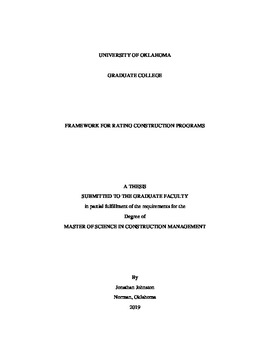| dc.contributor.advisor | Ghosh, Somik | |
| dc.contributor.author | Johnston, Jonathan | |
| dc.date.accessioned | 2019-12-18T14:35:22Z | |
| dc.date.available | 2019-12-18T14:35:22Z | |
| dc.date.issued | 2019-12-13 | |
| dc.identifier.uri | https://hdl.handle.net/11244/323247 | |
| dc.description.abstract | The internet and various print media offer a variety of ordinal ranking systems for colleges and universities. These rankings are readily available to everyone and offer a simplistic way to differentiate universities. However, these publications make little to no attempt to inform the end-user of the criteria by which the schools are ranked, or how the criteria are weighted, and the rank is developed. The goal of any rating system should be to accurately and transparently disseminate information to a designated end-user while avoiding the simplistic winner and loser paradigm. The term rating rather than ranking has been selected intentionally, to illustrate the comparative excellence of each program, not to simply name one as the best and others as less excellent. This document takes the first step to achieve this goal.
This research set out to create a framework for rating academic construction programs. The body of this work has taken the initial step to collect the criteria which will be considered for the rating framework. During the planning stages of this project, the research team identified three main objectives to be fulfilled. The first objective was to formalize the method of collecting the criteria that should be considered when measuring the excellence of academic construction programs. The second objective was to collect the criteria from three proposed sources: current research literature, a focus group of educators from Associated Schools of Construction (ASC) member schools, and one on one interviews with professors who held an administrative position for their respective department. The findings outline 87 criteria extracted from the sources. Finally, the third goal was to objectively create a consensus concerning the criteria and assign weights to these criteria. This document does not attempt to conduct a functional rating using the selected criteria based on the limited scope and resources of this research.
Through a modified Delphi method, a panel of experts has formed a consensus concerning which criteria should be considered and has assigned relative weights to the suggested criteria. The findings have been aligned with the conclusion and shown to either support or contradict other studies. The criteria limitations outlined in the conclusion portions of this document, arise from a time constraint. Suggestions for future research outline the next step required to create a rating system which accurately and transparently disseminate information to a designated end-user while avoiding the simplistic winner and loser paradigm. | en_US |
| dc.language | en_US | en_US |
| dc.subject | Framework for Rating Construction Programs | en_US |
| dc.subject | Identifying Factors to Compare and Rank-order Construction Programs | en_US |
| dc.subject | Selecting the Criteria to Compare Construction Programs | en_US |
| dc.subject | Ranking | en_US |
| dc.title | Framework for Rating Construction Programs | en_US |
| dc.contributor.committeeMember | Warnken, Charles | |
| dc.contributor.committeeMember | Bigelow, Ben | |
| dc.date.manuscript | 2019-12-13 | |
| dc.thesis.degree | Master of Science in Construction Management | en_US |
| ou.group | Christopher C. Gibbs College of Architecture | en_US |
